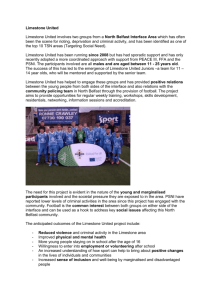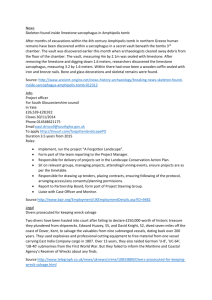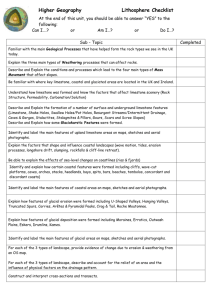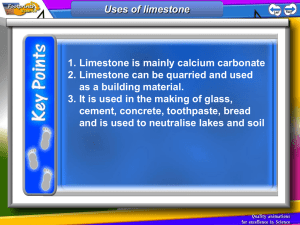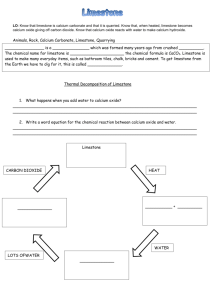geology & mineral resources of bundi district
advertisement
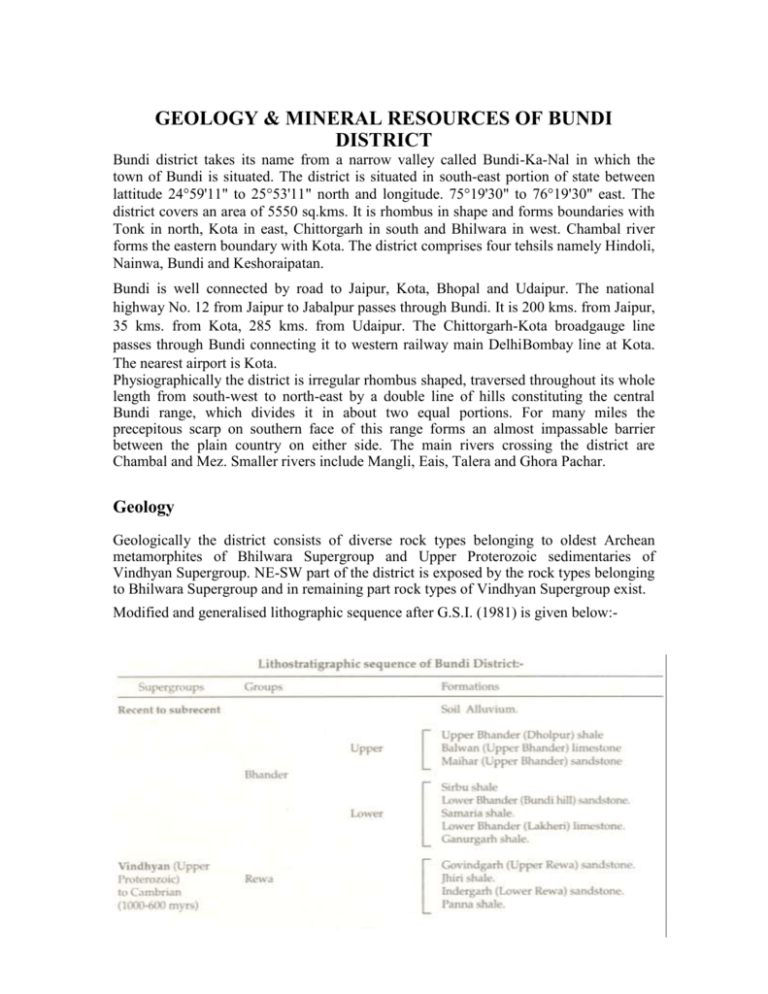
GEOLOGY & MINERAL RESOURCES OF BUNDI DISTRICT Bundi district takes its name from a narrow valley called Bundi-Ka-Nal in which the town of Bundi is situated. The district is situated in south-east portion of state between lattitude 24°59'11" to 25°53'11" north and longitude. 75°19'30" to 76°19'30" east. The district covers an area of 5550 sq.kms. It is rhombus in shape and forms boundaries with Tonk in north, Kota in east, Chittorgarh in south and Bhilwara in west. Chambal river forms the eastern boundary with Kota. The district comprises four tehsils namely Hindoli, Nainwa, Bundi and Keshoraipatan. Bundi is well connected by road to Jaipur, Kota, Bhopal and Udaipur. The national highway No. 12 from Jaipur to Jabalpur passes through Bundi. It is 200 kms. from Jaipur, 35 kms. from Kota, 285 kms. from Udaipur. The Chittorgarh-Kota broadgauge line passes through Bundi connecting it to western railway main DelhiBombay line at Kota. The nearest airport is Kota. Physiographically the district is irregular rhombus shaped, traversed throughout its whole length from south-west to north-east by a double line of hills constituting the central Bundi range, which divides it in about two equal portions. For many miles the precepitous scarp on southern face of this range forms an almost impassable barrier between the plain country on either side. The main rivers crossing the district are Chambal and Mez. Smaller rivers include Mangli, Eais, Talera and Ghora Pachar. Geology Geologically the district consists of diverse rock types belonging to oldest Archean metamorphites of Bhilwara Supergroup and Upper Proterozoic sedimentaries of Vindhyan Supergroup. NE-SW part of the district is exposed by the rock types belonging to Bhilwara Supergroup and in remaining part rock types of Vindhyan Supergroup exist. Modified and generalised lithographic sequence after G.S.I. (1981) is given below:- Bhilwara Supergroup has occupied NE-NW part of the district where rocks of Hindoli, Mangalwar & Jahajpur Groups are exposed. The Hindoli Group of rocks extend from village Hindoli in the west to the village Babi in east. The Jahajpur Group of rocks are exposed in the form of linear belt from Itunda in west to Nainwa village in the east. Pre Aravalli intrusives like granite & dolerites are exposed near village Basni, Deva Ka Khera & Odhanda of Hindoli tehsil of Bundi district. General trend of rocks is N 40° E with 60° NW dip. Vindhyan sedimentary sequences have occupied north eastern to southern part of the district. These are grouped as upper Vindhyan Supergroup (100-600 m.y.) and separated from Bhilwara Supergroup by a major reverse fault known as great boundary fault. All the three Kaimur, Rewa & Bhander Groups with their formations & members are well exposed. Rocks of Kaimur Group occur as outlier on the NW of Great Boundary fault in between Bundi Indergarh area. Rewa Group comprises Panna shales, Indergarh (Lower Rewa) sandstone, Jhiri shale and Ganurgarh (Upper Rewa) sandstone formations. Panna shale & Indergarh sandstone are exposed SW of Indergarh extending upto 5 kms. Jhiri shales & Govindgarh sandstone are persistent and both occur together in between Taragarh fort of Bundi and Indergarh for about 72 kms. Lakheri limestone of Lower Bhander sub group occurs in between greenish grey Samaria shale above and reddish brown Ganurgarh shale below and marked by intraformational conglomerate & breccia at the base and extends intermittently for 80 kms in 1-2 kms. wide belt upto Indergarh. Samaria shale is over lain by Bundi hill sandstone. Bundi hill sandstone constitute the Bundi hill and mostly exposed in the southern part of the district. The Sirbu shale is conformably underlain by the Bundi hill sandstone and over lain by Maiher sandstone occurring in eastern and southern part of the district. The Sirbhu shale limestone is generally confined in lower & middle part of the Sirbhu shale. The limestone in lower part is siliceous & dolomitic in nature, where as upper limestone is stromatolitic (siliceous) in nature but belongs to cement grade. Maihar sandstone occurs only in a hill on the east of Lakheri. Balwan limestone occurs conformably above the Maihar sandstone and is exposed near Kamaleshwar mahadev & in river Chaken. Its lower part is greyish, ferrugineous, arenaceous & cherty in nature where as upper horizon is pinkish & stromatolitic in nature. Dholpura shale conformably overlies the Balwan limestone & exposed near Dholpura, Daulatpura, Narayanpura & Sandelnala. It is pinkish, purple, reddish & brown in colour, thinly bedded & horizontally disposed. Quarternary sediments representing scree, talus, aeolian & alluvium. Alluvial is occupying the large part of the district where most of the part is undercultivation. Mineral Resources The most important mineral resources of Bundi are limestone and sandstone. The limestone deposits cater to one of the oldest cememt plant of state at Lakheri. However most of the deposits are marginal cement grade and also fall in forest. Other minerals include silica sand, marble, iron, clay etc. Details are given below: Limestone The occurrence of an extensive belt of Vindhyan limestone from Buncli to Lakheri is known since long. The oldest cement plant of Rajasthan at Lakheri (1917) is located at the eastern end of this belt. Limestone belonging to the upper Vindhyans is well exposed in most of the areas and extends for more than 60 kms. strike length. Limestone occurs in different bands from high hills to foot hills and is of grey and pink colour. There are two fairly wide shale bands separating the limestone bands around Bundi. The limestone is commonly massive and fine grained~The grey and upper limestone is mostly marginal to cement grade while pink or lower limestone is low grade due to shale partings and intercalations. Almost entire deposit is close to the Kota-Jaipur highway. The nearest railway station is Bundi in west on Kota-Chittorgarh broad gauge line and Indergarh in east on Kota-Delhi main line. Limestone deposit near Bundi The limestone deposit near Bundi lies around villages Satur, Haripura, Ganpatpura, Khatkar, Rampuria, Saipura, Keshopura, Baldeopura, Kundaliya, Kathiary, Kuagaon, Pholai, Phutatalao, Chipalta etc. The nearest railway station is Bundi. The limestone belongs to Bhander Group of Vindhyan Supergroup and is exposed over a strike length of 60 kms. trending ENE-WSW. For description purpose these deposits can be divided into following different blocks. (a) Satur-Haripura Area The limestone deposit of Satur is located about 8 kms. west of Bundi, on Kota-Ajmer state highway. Limestone occurs as alternating bands of pink and grey limestone. The pink limestone is marginal cement grade. The analysis results show average CaO 43.3%, MgO 2% and Si02 15%. Near Satur, limestone occurs in two bands formed due to folding. The southern band is named as Haripura block. On the basis of surface work, G.S.I. has estimated about 500 million tonnes reserves in this part of the belt. The State Department has carried out investigation in part of Satur area carrying out 397 mts. drilling spread over 21 boreholes and proved 21 million tonnes reserves under drill indicated and 14 million tonnes in inferred category: In part of this block (25° 25', 25° 30', 75° 25', 75° 30'), cement corporation of India carried out detailed investigation around Tabgaon Haripura, Satur in Hindoli tehsil and Saipura, Ganpatpura of Bundi tehsil. On the basis of exploratory drilling totalling 3990 mts. spread over 73 boreholes, 45.90 million tonnes reserves have been proved. Almost entire area falls in reserve forest. (b) Ganpatpura-Khatiari Area: This limestone block extends for a strike length of 14 kms. via. Saipura, Barwas, Kundalia, Rajwas, Khatiyari villages with average width 150 mts.. Department has carried out investigations in Kundalia, Ganpatpura over a strike length of about 4 kms. and established 36 million tonnes reserves on the basis of 8 boreholes totalling 443 mts. drilling. The average grade of limestone is CaO 43.5%, MgO 1.10% and Si02 17.05%. It can be used for cement manufacture by adding sweetner. (c) Kuagaon-Pholai Area In Kuagaon-Pholai area, limestone belt extends for about 2 kms. in length with average width of 150 mts. The limestone is dark grey in colour, fine grained, hard and compact with shale partings. The average grade is CaO 43.56%, MgO 1.19% and Si02 17%. Drilling operations were carried out comprising 339.20 mts. drilling spread over 8 boreholes. Reserves of about 10.83 million tonnes have been assessed in drill indicated and 7 million tonnes in inferred category. (d) Dalelpura-Bhaironpura-Meznadi-Piplantari Area The limestone belt extends for a strike length of 8.8 kms. with average width 330 mts. from Dalelpura to Bhaironpura. Limestone occurs in foot-hills dipping against sloping ground. The analysis results show CaO 45-48% and MgO 1-1.5%. From Bhaironpura to Mez nadi via Gulkheri, the limestone belt has a strike length of 12.8 kms. and average width 79 mts. The area falls in reserve forest. M/s. Upper Ganges Sugar Mills Ltd., have carried out investigation in Bhaironpura-Gulkhari area for a strike length of 10 kms. and proved 30 million tonnes reserves. The further extension of the belt is from Mez nadi to Piplantari for a strike length of 12 kms and width 60 mts. having CaO content from 45 to 48.6% and MgO 1-2%. G.S.I. has carried out surface investigation in all these areas and assessed reserves in different blocks as given below: 1. Dalelpura-Bhaironpura Block: 106.70 million tonnes 2. Bhaironpura-Meznadi Block: 38.90 million tonnes 3. Meznadi-Piplantari Block: 31.10 million tonnes Limestone deposit near Phutatalao-Chipalata Area The limestone band occurs 1.5 km. west of Phutatalao and extends for a strike length of app. 5 kms. with average width of 64 mts. This band occurs in between the two main limestone bands. The limestone contains CaO 44 -47% MgO 1-1.15% and SiO2 12-15% G.S.I. has assessed about 12 million tonnes reserves on basis of surface explorations. Limestone deposit near Durwasanath temple and Sarodara The limestone exposures near Durwasanath temple and Sarodara area belong to Bhander Group of Vindhyan Supergroup and extends over a strike length of 4.5 kms. and width 800 mts. The limestone is grey, chocolate and red in colour. Grey limestone is of cement grade whereas chocolate one is interbedded with shale partings and is of low grade. The analysis results show CaO 42 to 52%, MgO 0.2 to 2% and SiO2 6 to 17% with low alumina and iron. 432 mts. drilling has been carried out, spread over 11 boreholes, estimating about 50 million tonnes reserves in 1.7 km. long belt. Entire area falls in reserve forest. Limestone deposit near Datunda and Basoli The Deposit lies between Datunda and Basoli villages of tehsil Hindoli. The nearest railway station is Bundi which is about 30 kms. The limestone deposit belongs to Bhilwara Supergroup and extends over a strike length of 3 kms. with average width 25 mts. It occurs in discontinuous patches intercalated with shales and phyllites. Limestone is pinkish white and green in colour. Six boreholes were drilled in the area by the department totalling 180.50 mts. drilling. A total of 1.83 million tonnes reserves have been proved containing average CaO 43.7%, MgO 0.68% and SiO2 18%. Partly the area falls in reserve forest. Limestone deposit near Bari Javati The limestone deposit near Bari Javati extends for about 1.5 kms. occuring intermittantly having a width of about 30 to 46 mts. of dolomitic limestone and 110 to 152 mts.. of grey and pink limestone. The limestone belongs to upper Vindhyans. Department has carried out investigation by putting 5 boreholes totalling 135 mts. drilling. The CaO content varies from 32 to 45%, MgO 0.5 to 3.2% and SiO2 4 to 19% No. workable zone of cement grade limestone was found. Limestone deposit near Lakheri and Indergarh The Bhander limestone near Lakheri is being exploited since 1917 for cement manufacture. About 60 million tonnes reserves of cement grade limestone were estimated under drill indicated and inferred categories to meet out the requirement of cement plant located at Lakheri. (capacity 0.66 million tonnes of cement per annum). The plant is owned by Associated Cement Company Limited. In Indergarh area a reserve of 20 million tonnes of cement grade limestone has been assessed by the department. The deposit is 5 kms. away from the Indergarh railway station which falls on BombayDelhi broad gauge section of western railway. Presently the limestone of this area is being utilised by A.C.C. as a sweetner. In addition, there is a low grade limestone deposit containing 32 to 40% CaO near village Nanta-Kualji, tehsil Keshoraipatan. Silica Sand It is an important raw material for glass industry. A good quality Silica Sand deposit is located near Barodia in Bundi tehsi110 kms. from Bundi. The deposit falls along the Great Boundary fault, which brings the Aravalli against lower Bhander sandstone of Vindhyan Supergroup. The deposit is exposed in about one km. long and 100 mts wide belt. Silica Sand contains as high as 99% Silica with 0.05 to 0.14% iron. Other areas where Silica Sand occur are Tikarda and Dhulsagar. Barytes Baryte occurs in form of veins associated with quartz veins in dolomitic limestone near Umar-Babi villages. There are two small baryte veins which occur for a strike length of 100 mts. containing white to grey colour barytes, about 1500 tonnes of reserves are inferred. Marble Marble is found in Bundi district near Umar and Basoli villages. The marble is siliceous in nature with 12 to 18 % MgO and is pink, white, grey and greenish in colour. At places marble is quite massive in nature and blocks can be extracted which takes good polish. Clays There are occurrences of low grade kaolin clays in Bundi district. China clay occurs near Manak Chowk, Sagodia, Mandpur and Satur and is used in whitewash. Granite Granite deposits of blockable nature has been identified near Basni & Devkheda villages of Hindoli tehsil. The granite is reddish in colour, exposed for about one km. length. Sand Stone The lower Bhander sand stone in Bundi district has given good splittable sandstone deposits. There are known working quarries around Dhansuara, Dabi, Parena, Dhonla, Bapu, Budhpura, Laubakho, Naroli, Polopara, Rajpura and Gudlica etc. The sand stone is pinkish, bluish, grey to brownish in colour, fine to medium grained jointed and well bedded with flat dips. Splittable sandstone generally occurs below 1 to 1.5 mts. massive sandstone and has a thickness of 3 to 4 mts. 12 lakh tonnes production was done in 199899 from 1355 leases. Red Ochre It is found near Basani, Khiniya and Basoli villages of Hindoli tehsil, associated with phyllites and quartzites. Iron Ore Poor grade Iron ore occurs near Indergarh-Mohanpura, containing 28.49% to 55.95% Fe203 Slate Stone Slate Stone occurs near Babaji Ka Khera, Narenpura and Dainda villages of Hindoli tehsil. There are 8 mining leases. Mineral Based Industries Among major mineral based industries, older cement plant of the state, Associated Cement Companies Ltd. was installed near Lakheri town of Keshoraipatan tehsil of Bundi district in 1917 with production capacity of 6.60 lakh tonnes per annum using lime stone of Lakheri - Gandoli area, Kotri - Khemli area & Sandalnala areas. Other important major mineral based industries are Silica Pulverizing Plant near village Barodia of Hindoli tehsil of Bundi district using silica sands mainly from Barodia silica sand mine. There are 36 minor mineral based industries in the district. Among these 18 are stone cutting & polishing units (mostly in Bundi teh.) one fire brick making plant (Nainwa), four stone grit plants, four brick kilns & remaining nine are the lime kilns. There is scope of putting up of more lime units and stone cutting & polishing units. Mineral Administration Looking to the large number of areas of sandstone/ limestone etc. the Mineral Administration work in the district is being looked after by two Mining Engineer offices. Mining Engineer Bundi-I and Mining Engineer Bundi-II. Their work is supervised by Superintending Mining Engineer Kota. The geological work is carriedout by office of Senior Geologist. Which is under Superintending Geologist Jaipur. This office looks after the geological work in Kota, Bundi, Sawai Madhopur, Karauli, Jhalawar and Baran districts. The telephone numbers of these offices are given below: 1. Mining Engineer Bundi-I 0747-22632 2. Mining Engineer Bundi-II 0747-22426 3. Senior Geologist Kota 0744-325110 During the year 1999-2000 work on 3 projects was carried out in Bundi district. 1. Mineral Survey for decorative shales, schists, and other economic minerals in Hindoli tehsil, Bundi. 2. Mineral Survey for barytes and other economic minerals, Tehsil Nainwa & indergarh, Distt. Bundi. 3. Evaluation of sandstone deposits and study of non-splittable sandstone for cutting and polishing Bundi district. For the year 2000-2001 one project has been proposed for geological work. 1. Regional Mineral Survey for splittable sandstone near Rakan, Kamalpur etc, tehsil & distt. Bundi. Unpublished Geological Reports of Bundi District (A) Geological Survey of India and others (Available with Department of Mines and Geology) Malhotra, G.; 1988-90 : Metamorphic transect studies on the Mangalwar and the Hindoli rock requences in parts of Tonk and Bundi districts. Singh, R.S. Murthy, K.S.K.; 1966 Report on the study of stromatolite from the precambrian and cambrian rocks of Udaipur, Chittorgarh, Bundi and Kota districts. Crook Shank: Geological report on Bundi state. Mehta, D.R.S. & Puri, S.N.; 1949 : Report on glass sand deposit near Barodhia. Basu K.K.; 1959-60 : Note on the preliminary investigation of limestone deposit northeast of Bundi. Prasad, Balmiki & Zutsi, Yoginder; 1972-73 : Systematic Geological mapping and limestone sampling in parts of Bundi. Prasad, Balmiki & Ramasamy, Somasundaram; 1976 : Geologycal mapping in parts of Bundi & Kota districts. Sharma, S.B. & Prasad, Balmiki; 1973-74: Geological mapping in Khinya Ladpura, Bijoliya & Rawatbhata areas, districts Bundi, Bhilwara & Chittorgarh. C .Rama Mohana; 1974-75 : Report on systematic geological mapping in parts of Bhilwara & Bundi districts. Reddy, U.S.N.; 1975-76 : Systematic geological mapping in parts of Bundi & Bhilwara districts. Prasad Balmiki; 1974-75 : Geological mapping in Mandalgarh, Dabi-Kota area, Bhilwara, Chittorgarh, Bundi & Kota districts. Ray, J.H. & Reddy U.S.H.; 1978-79 : Systematic geological mapping in parts of Tonk & Bundi districts. Das Gupta, D.J.; 1984-86: Investigation for base metal mineralisation between Gokulpura & Amargarh & between Gokulpura & Sakargarh Bhilwara & Bundi districts. Jain, P.C.; 1984: A report on investigation for cement grade limestone near Bundi. Sharma A.K. & etal; 1987-88 : A report on systematic geological mapping of Hindoli and Jahajpur Groups in parts of Toposheet No. 45 0/9, 13, 14 & 54 C/1 in Bundi; Tonk & Sawai Madhopur districts. Sharma A.K.; 198-87 : A report on systematic geological mapping of Hindoli and Jahajpur Groups in parts of Toposheet No. 45 0/10, in Bundi & Tonk districts. Malhotra, g. & Ray S. Sinha; 1984-85 : Geology & base metal pontentials of the Jahajpur belt in parts of Bhilwara and Bundi districts. Benerjee, S.K.; 1987-88: Reports on the reconnoitory survey for phosphorite in the Jahajpur group of rocks in Bhilwara & Bundi districts. (B) Department of Mines & Geoloy, Udaipur Sharma K.C. : Interim report of mineral investigation in Begun and Khakhera area. Joshi, Q.L. : Prospecting report on the iron ore deposit and clay deposit near Luharpura. Keshwani K.B. : A report on reconnaissance survey for economic minerals in Bundi. Agrawal, J.P. : A report on the investigation of barytes deposits in the Umar-Pagara area. Agrawal, J.P., Bhargava, K.D.: A report on geological exploration of limestone deposit near Satur. Ashok Kumar, Patani, S.K. : Basemetal investigation in Itaunda Nainwa belt. Sharma, J.P., Gaur, P.K. & Sharma, M.M. : A report on reconnaissance for economic minerals in Bundi and grid pattern sampling of Katunda limestone. Sharma, J.P., Bhatnagar, A.P. : A report on the investigation for copper and clay near Datunda and Bhanao, tehsil Hindoli. Babel, G.L. : Investigation report for sulphide ores in Umar-Pagara area. Bhargava, K.D. : A note on the marble deposit near village U mar Sharms, J.P., Mathur, R.P. & Bhatnagar, A.P.: A report on the greological mapping at Umar marble area, tehsil Hindoli. Bhatnagar, A.P. : A report on reconnaissance done during the year 1979-80 for economic minerals in Bundi. Babel, G.L. : A report on reconnaissance for economic minerals neer Sultanpur, Kapren, Badet. Jamrani, S.S. : A report on reconnaissance for barytes and other economic minerals around Karwar, Kashipura, Belawati, Babi villages. Babel, G.L., Ravi Dayal & Jamrani, S.S. : A report on the assessment for clay and iron ore in Indergarh and Mohanpura area. Babel. G.L., Jamrani, S.S. :A report on the reconnaissance in Bundi district for barytes, fluorite and other economic minerals. Purohit, S.N., Ravi Dayal & Agrawal, S.C. : A report on investigation for cement grade limestone near Durbasanath temple. Ali, S.F., Ravi Dayal : A report on investigation for cement grade limestone near Phetai, Khatkar. Ashok Kumar : A report on basemetal investigations in Itunda, Nainwa area. S.N. Purohit, S.K. Swami : Investigation for Cement grade limestone near village, Kundaliya, distt. Bundi S.N. Purohit, S.K. Swami : Investigation for Cement grade limestone near village Kundaliya & Ganpatpura, distt. Bundi. S.N. Purohit : To locate splittable sandstone by reconnaissance in area around Laxmipura, Dora and Kuni district Bundi. S.K. Swami : A report on delineation for granite areas near Basni-Dewa ka khera teh. Hindoli, district. Bundi. S.K. Swami, S.N. Purohit : Reconnaissance for granite, clays and other economic minerals around Umar, Basni and Kishanganj, distt. Bundi S.K. Swami, T.S. Ranawat, S.N. Purohit : Prospecting for cement grade limestone around Bari-Javati, Dayalpura, Tehsil & district Bundi. Suptdg. Geologist, Kota : A status note on limestone deposits of the Bundi distt. Including posibilities of new deposits. J.P. Sharma, S.K. Swami, S.N. Purohit : Investigation for Cement grade limestone near village Sarodara & Datunda teh. Hindoli district Bundi. J.P. Sharma, S.K. Swami, S.N. Purohit : Investigation for Cement grade limestone and dolomite near village Sarodara tehsil Hindoli district Bundi. S.N. Purohit : Investigation for Cement grade limestone near village Balevpur-Rajwas distt. Bundi. S.N. Purohit : Investigation for Cement grade limestone near Akber and Baswas distt. Bundi. S.N. Purohit : Regional assessment of limestone around Jharbalanpura, Ganpatpura, Saipura upto Bundi in Distt. Bundi. S.K. Swami, S.N. Purohit : Reconnaissance for basemetal and other economic mineral around Bundi-Ka-Gothara, Jalawar, Korma, Gardhari and Nainwa & to prove the basemetals by drilling in tehsil Nainwa district Bundi. S.K. Swami, S.N. Purohit : Basemetal exploration by drilling in Korma, Gardhani and Devdhuwa blocks in teh. Nainwa district Bundi. J.P. Sharma, S.K. Swami, S.N. Khan, S.N. Purohit : Reconnaissance for splittable sandstone and other economic minerals around Dhaneshwar, South of Gudan, Patiyalpura, Kharipur and Shivpur district Bundi. J.P. Sharma, S.K. Swami, S.N. Khan, S.N. Purohit : Investigation for splittable sandstone by drilling in Dhaneswar & Shivpura area district Bundi. G.L. Babel, S.S. Jhamrani : A report on regional assesment of limestone & sandstone deposits of Bundi distt. Ravi Dayal, O.S. Sukhwal : Investigation for Cement grade limestone near DatundaBasoli, Teh. Hindoli, Distt. Bundi. S.K. Swami, S.N. Purohit : Reconnassance for copper, decorative stones and other economic minerals around villages Gokulpura, Thana & Vijaygarh, Teh. Hindoli, Distt Bundi. H.A. Danish : A report on geographical investigation basemetal in Nainwa area distt. Bundi. MINERAL STATISTICS OF BUNDI DISTRICT - 1998-99 MINOR MINERALS 1. Fuller's Earth 2. Granite 3. Kankar Bajri 4. Limestone 5. Marble 6. Masonry stone 7. Sand stone 8. Slate stone 9. Mis. MAJOR MINERALS 1. Calcite 2. China Clay 3. Limestone 4. Ochers 5. Silica sand 2 0 0 39 6 16 1355 8 0 0.933 0.000 0.000 133.364 0.010 40.107 1266.778 0.107 0.000 0.090 0.000 0.000 173.370 0.006 3.640 6858.230 0.510 0.000 11.900 5.000 481.700 4051.570 111.600 676.000 53859.190 138.300 3328.620 1 1 3 2 2 0.000 0.000 526.351 3.157 19.753 0.000 0.000 894.800 0.630 69.130 1.300 6.200 17091.100 44.200 276.400




